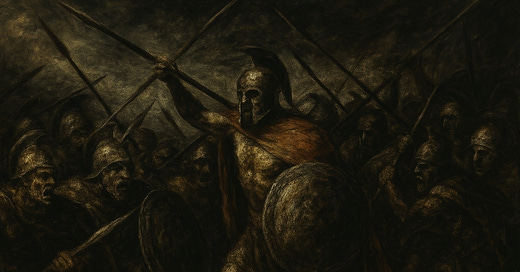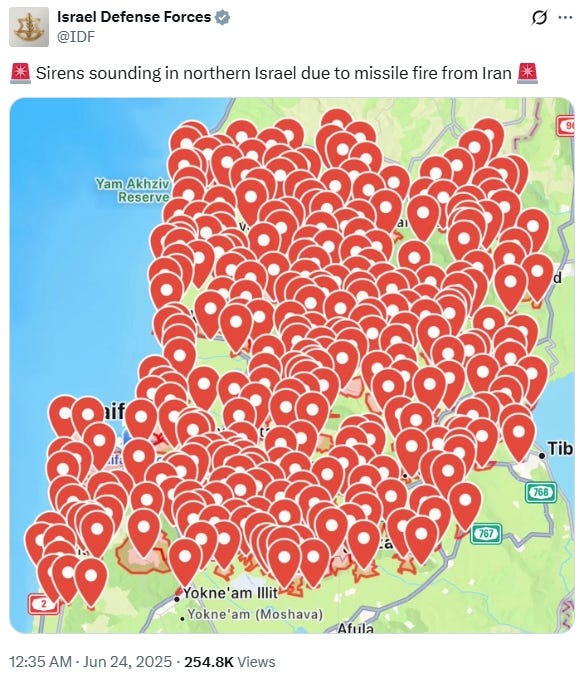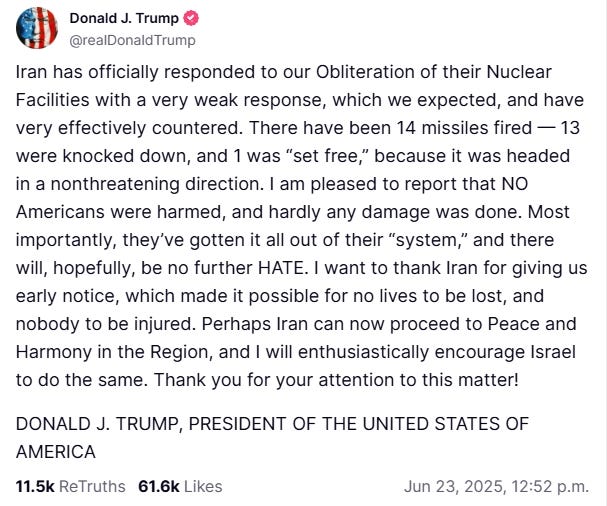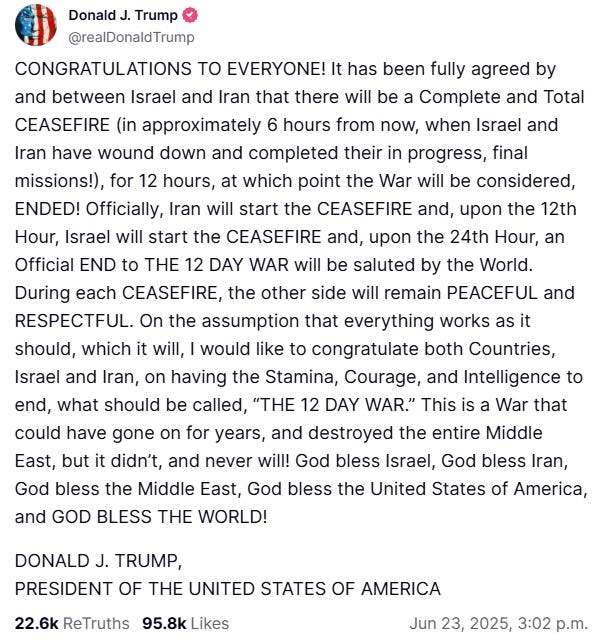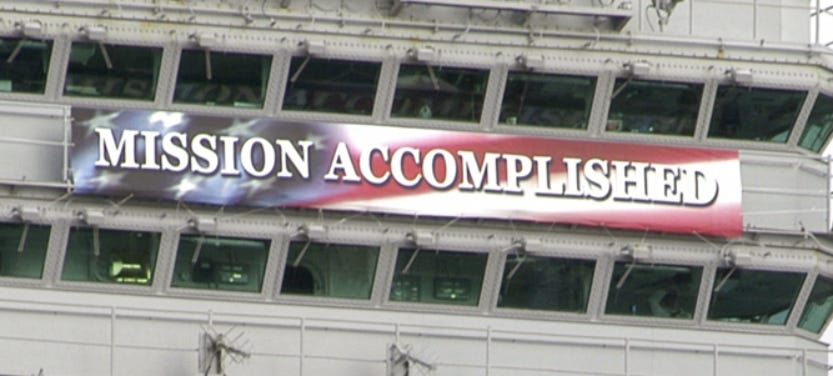The ceasefire brokered by Trump between Israel and Iran is now in effect.
12 minutes in, Iran had already violated it with the first missiles fired at Israel. And as I write this, the IDF’s official X account is now showing sirens all across northern Israel due to missile fire from Iran. Update: by morning the IDF reported that it intercepted 15 UAVs overnight and is planning to respond with force against this violation of the ceasefire.
For those who have been following the ayatollahs’ activities over these past 46 years, this was not unexpected. But the diplomats who brokered the deal and Trump himself who has welded his reputation to this ceasefire deal must all be pulling their hair out as they try to figure out how to get this ceasefire to hold without returning to planes and bombs.
The exiled Crown Prince of Iran, @PahlaviReza, has also warned about how things will evolve from here: “this regime will not submit or surrender after it has been humiliated. It will lash out. As long as it is in power, no country and no people are safe.”
As always, and especially in war, there is so much more to the story than the simple narratives that both peaceniks and neo-cons would have us believe. Not all problems can be solved through diplomacy. And not all problems can be solved with bombs. Knowing which solution to apply to which problem — and getting the timing right — is the ever-lasting challenge that has bedeviled foreign policy since the beginning of time. Unfortunately, for most of the last 80 years, America has been getting it wrong… and the people are tired.
~ ~ ~
“In war, truth is the first casualty.”
These words, recycled innumerable times since, were first written in the 5th century BC in ancient Greece by Athenian playwright Aeschylus, known as the father of the Greek tragedies — that very specific ancient Greek genre of theatrical drama characterized by stories of the downfall and suffering of prominent figures, often due to a combination of fate and their own flaws.
His oldest surviving play, called The Persians, was based on historical events in the Greco-Persian War, in which a league of Greek city-states, led by Sparta and Athens, collaborated to stop the autocratic Persian Empire’s westward expansion as it sought to subjugate Greece.
This historical war wasn’t just an existential threat to ancient Greece. By extension, it is widely considered to have been a pivotal moment in the cultural evolution of Western Civilization because had the Greeks lost this war, ancient Greek ideas about democracy, individual freedom, personal and political autonomy, civic participation, rational inquiry, and intellectual freedom would all have been suppressed long before they had a chance to spread to Europe where they evolved to become the foundational ideas of European civilization. Had the autocratic Persian Empire been victorious in its quest to conquer the Greek city-states and turn them into submissive provinces, those cultural, philosophical, and intellectual ideas would have been strangled.
Aeschylus himself personally fought as a citizen-soldier against the numerically superior Persians at the Battle of Marathon in 490 BC, which marked the end of Persia’s first invasion of Greece by Darius I. After Darius died in 486 BC, the second invasion of Greece began under his son, Xerxes I. Once again, Aeschylus fought on the Greek side in 480 BC at the famous naval battle known as the Battle of Salamis. In this battle, the Persians were personally led by Xerxes. Xerxes’ defeat at Salamis by the Greek alliance marked a key turning point in the second Persian invasion of Greece.
For context, those who have watched Hollywood’s 2006 epic historical action film, 300, will be familiar with the famous Battle of Thermopylae, which occurred only a month or two before the Battle of Salamis.
At that Battle of Thermopylae, a small force of 300 Spartans along with a thousand or so of their allies (led by King Leonidas of Sparta), fought to the death against Xeres’ vast army in the narrow mountain pass of Thermopylae in order to block the Persian army’s advance through this narrow geographical chokepoint on their march towards central and southern Greece. That crucial self-sacrificing battle provided the critical delay to allow Athens and the other city-states to evacuate their populations ahead of the Persian army’s advance into Greece and mobilize their naval forces in preparation for the massive Battle of Salamis that followed soon afterwards.
The Greeks ultimately won their long war against the Persians and preserved their autonomy despite the fact that, throughout the war, the Greeks were vastly outnumbered by the Persians. Greek writers like Herodotus emphasized the contrast between the Greeks, fighting as free citizen-soldiers in defense of their autonomous city-states (and thus with a personal stake in the outcome of the war) versus the conscripted troops of the imperial Persian army, raised by draft from subjected peoples.
At the Battle of Marathon, the outnumbered Greeks managed to lure the overconfident Persians into a tactically brilliant pincer move that negated the Persians’ numerical advantage as the wings of the Greek army folded around the Persians to completely envelope them. That battle exposed that the vast Persian army could, in fact, be beaten and broken.
In the second phase of the war, using the time bought by the suicidal sacrifice made by the 300 Spartans and their allies at the Battle of Thermopylae, the Greeks deceived Xerxes with false messages to lure his massive navy into a cramped and narrow straight between the mainland and the island of Salamis. In these crowded conditions, the numerically superior Persian navy, which outnumbered the Greeks 2 to 1, was again put at a crippling disadvantage that allowed the smaller number of Greek ships to decisively ram, sink, and scatter the Persian fleet. Although the war continued on for several more decades before a lasting peace treaty was eventually signed, even modern scholars like Victor Davis Hanson emphasize Salamis’ strategic importance — it was the battle that prevented the main Peloponnese peninsula from being overrun, it re-enforced unity among the Greek allies, and it set the stage for the eventual expulsion of Persian forces, thereby securing Greek independence and cultural development.
The later Peloponnesian War between former allies Athens and Sparta, which I have written about previously, was waged 50 years after the Greco-Persian War. By then Athens and Sparta had become rival powers vying for control over the entire Greek peninsula. Known as the Thucydides Trap as each side built up its army out of fear that the other was doing the same, the war emerged as a consequence of the escalating rivalry and distrust between these two dominant city-states. The Spartan side ultimately launched the first military strike out of fear that the Athenian side would strike first at a time and place of their choosing. But despite its savagery, the Peloponnesian War was nonetheless more of a “fraternal war” between Greek city-states, in which both sides shared the same language, culture, religious practices, and moral values even as they fought for power and influence and to decide which of their competing political systems would control Greece.
By contrast, the earlier Greco-Persian War was truly a clash of civilizations, each with entirely different visions of how to govern their worlds, with different cultures, with different religions, and with entirely different moral lenses through which they viewed the world. On the one side stood Greece’s autonomous democratic or oligarchic city-states with their citizen-soldiers. On the other side stood an aggressive, imperialistic, and expansionist Persian Empire, which demanded unquestioning loyalty to its centralized, autocratic rule, and whose expansionist ethos was morally framed as a divine mandate to unite the known world under their tyrannical king’s rule, and with an army obligated to serve as a condition of their serfdom.
Ancient Greek writers like Simonides, Herodotus, and even Aeschylus himself all framed this Greco-Persian War as a civilizational struggle between free, virtuous Greeks and despotic, servile Persian rule.
~ ~ ~
Some wars are avoidable and should never be fought — and to blunder into them exposes the moral and intellectual failings of an entire generation. Some wars are unavoidable and must be fought pre-emptively at a time and place of your choosing to stop an enemy that is growing in strength. And some wars, much like the battles at Marathon, Salamis, and even the tragic battle at Thermopylae, are existential, unavoidable, and must be fought at all costs because all of civilization and your entire way of life is at stake, because delay only increases the risks, and because the alternative to fighting is unthinkable even if fighting demands the ultimate sacrifice.
Unfortunately, in a world awash with self-serving liars, opportunists, and propaganda artists, it’s often not so easy to tell which war is which.
~ ~ ~
As the war between Israel and Iran escalated and Israel begged America to help it “finish the job” of eradicating Iran’s nuclear weapons sites and toppling Iran’s theocratic authoritarian state, a bitterly divided America hummed and hawed about whether or not to enter the fray.
After initially leaving Israel to fight this war on its own, Trump decided to get involved with a symbolic limited strike against Iran’s nuclear facilities, which are buried too deep for Israel’s bombs to reach, but which some critics say were likely already evacuated of all equipment in expectation of the U.S. strikes. Meanwhile, the rest of the free world watched from the sidelines, unwilling to risk even a broken fingernail to try to stop the Iranian regime, while repeating their endless calls for more diplomacy with a hostile ideological regime that has demonstrated for more than 46 years that it exploits diplomacy as a tactic to deceive the West, advance its nuclear and regional ambitions, spread chaos among its neighbors, and capitalize on perceived Western weakness.
With this first show of strength behind him to establish that the alternative to diplomacy is war, Trump called for… a return to more negotiation.
The Iranians responded to the U.S. strike by doubling down on their threatening rhetoric, by reaffirming their commitment to their nuclear program, and by threatening to close the Strait of Hormuz to shipping. Their allies the Houthis likewise announced that they were withdrawing from their earlier ceasefire with Trump and would return to attacking shipping in the Red Sea. And nuclear-armed Pakistan made threats to join the fray on the Iranian side.
And then the Iranians responded militarily… with a mere 14 missiles launched against the U.S. airbase in Qatar. And they provided advance notice to both the U.S. and to Qatar to give them time to evacuate personnel and prepare countermeasures. 13 of the 14 missiles were duly shot down and one was allowed to hit the ground on a trajectory that posed no danger to anything or anyone. No-one was hurt. And, notably, Bahrain, Kuwait, Oman, Qatar, Saudi Arabia, the UAE, Egypt, Morocco, Jordan, Lebanon, Turkey, the Palestinian Authority, and even Yemen all immediately weighed in to condemn Iran’s missile strike — the fact that it was Iran and not the U.S. that they all condemned reflects the degree to which the Middle East is tired of Iran’s antics. It would seem that Iran has been beaten back into its corner.
Trump then posted a victory lap on Truth Social, in which he said that the Iranians have now “gotten it all out of their “system” and that “there will, hopefully, be no further HATE.” He thanked Iran for giving them advanced notice and suggested that “Perhaps Iran can now proceed to Peace and Harmony in the Region”.
Hours later, Trump announced that Israel and Iran had agreed to a full ceasefire, that the war is now over, and that everyone would now remain peaceful and respectful.
Western social media is celebrating.
The optimist would say that all it took to cow Iran into submission and force it to let go of its hate and its nuclear ambitions was to re-establish deterrence to make Iran understand that there’s a real credible threat of violent consequences to back up diplomatic efforts. If true, then generations of failed diplomatic negotiators have egg on their face. Apparently, all those years of failed diplomacy, broken promises, pallets of cash, and gruesome deaths at the hands of Iran’s proxies could have been avoided if someone had just flown a few planes and dropped a handful of bombs to knock some common sense into the ayatollahs. More than a few voices are crowing that Iran has now been exposed across the region as a paper tiger.
By that line of reasoning, all it took was 12 days of war and one night of U.S. strikes against three empty Iranian nuclear sites to frighten the Iranians enough to amend their 46-year-old ways and trigger a religious re-awakening to purge themselves of the hatred at the core of the Ayatollah’s theocracy. WWIII has been averted and now the Middle East will live happily ever after. The end. Surely someone deserves a peace prize for this…?
Forgive me if I have my doubts — has everyone forgotten who we’re dealing with here?
In 1980, just after the Iranian Revolution that swept the ayatollahs to power, Saddam Hussein invaded Iran, partly because he wanted Iran’s oil and partly to try to neutralize the ideological threat that the Ayatollah Khomeini posed to Saddam’s regime as the Ayatollah called for Islamic revolution and fomented revolutionary sentiments among Iraq’s Shia community (between 55-69% of the Iraqi population).
To get a sense of the fanatical grit of Iran’s new theocracy, that 8-year-long Iran-Iraq War cost the lives of between 1 and 2 million people before grinding to a stalemate, with Iran suffering the heavier losses (up to 600,000 military deaths and 150,000 civilian deaths, compared to Iraq with up to 300,000 military and 100,000 civilian deaths). Throughout, Iran was significantly out-gunned compared to the Soviet-backed Iraqi army and its army’s command structure was in tatters because so many of its officer corps had been purged during the Iranian Revolution. Yet it made up for it with ideological zeal as it poured wave after wave of volunteer and conscript soldiers into the war.
One of its strategies, illustrating how little the ayatollahs care about the safety or survival of their own people, was to use “human-wave” attacks, which involved sending large numbers of lightly equipped infantry, often teenagers, to charge across open ground towards Iraqi lines. The goal was to overwhelm the enemy through sheer numbers, but they often resulted in massive casualties for the Iranians. Throughout, Iran made extensive use of child soldiers, some as young as nine years old.
Likewise, strapped for cash and equipment, Iran came up with a particularly cruel solution to clear mines — by sending young Iranian children to clear mines. These children (their nation’s own children!!!) were brainwashed into martyrdom — they were given plastic keys to hang around their necks and were promised that they would go directly to heaven if they died as martyrs by participating in the struggle against the Iraqi army. In addition to being blown to smithereens by the thousands in the minefields, these brainwashed children were also sent on countless suicide missions. Estimates of how many of these child-soldiers died while sweeping mines or on suicide missions range from thousands to tens of thousands.
Does that sound like a regime that’s likely to be reformed, contained, or intimidated by a few decapitation strikes and bunker buster bombs? Or does that sound like a regime that’s more likely to use the ceasefire to regroup and pivot to new strategies before lashing out via asymmetrical warfare and via its proxies in order to exact its revenge?
Trump’s declaration of victory reminds me of George W. Bush’s overconfident televised speech on the aircraft carrier in 2003 to announce the end of the Iraq War, in which he declared “Mission Accomplished” and that “major combat operations in Iraq have ended.”. Soon afterwards, the Iraqi insurgency gained pace and turned into an 8-year outright sectarian war that was largely (but not exclusively) fought between Iraqi Sunni groups and Iranian-supported and Iranian-funded Shiite militias operating on Iraqi soil. As Wikipedia reports, the vast majority of the casualties of Bush’s Iraq War occurred after that infamous speech and included up to a million Iraqi civilian deaths. President Bush’s Press Secretary later “clarified” that the banner had been poorly worded and should have said “Mission accomplished for these sailors who are on this ship on their mission.” Huh? If you say so, Mr. Bush. 🤔
What’s to stop Iran’s future nuclear ambitions — more diplomacy and IAEA monitoring? What’s preventing Iran from continuing to fund terrorism and spread chaos throughout the region and beyond — Iranian goodwill? Have Iran’s cyber operations been wound up? Has the spread of the ayatollah’s hate-filled ideology been curtailed? Exactly how has Iran been contained?
Iran has always preferred asymmetric attacks via proxies to direct and open war — what’s to stop it from ramping those up again soon to gain vengeance even as it secretly restarts its nuclear program? I mean, seriously, what’s changed? After everything that’s happened, there’s even a possibility that it might find a way to secretly purchase a nuclear bomb from Pakistan or North Korea to accelerate its path to nuclear deterrence. In the meantime, the ceasefire deal buys the Iranian regime some time.
I’ll get to how naïve Trump’s “mission accomplished” declaration is in a moment as we dig deeper into the ideological beliefs driving the Iranian regime. Or, maybe this is just 4-D chess as Trump allows the duplicitous Iranians to expose to the world who they really are in order to build support at home and heal the rift inside his own party before resorting to a bigger hammer. Maybe.
But before we dig deeper into the deceptive and hateful world view of the ayatollahs’, I want to peel apart a development that emerged on the American home front, which likely played a big role in Trump’s response with this symbolic strike (and which will continue to complicate his ability to use military force in the future) — it may help explain why Trump opted for this face-saving “solution” that merely punts the Iranian problem down the road… again… instead of “finishing the job”.
Before I dive into the remainder of this essay — into the growing anti-war movement emerging on the political right that severely constrains Trump’s ability to expand U.S. involvement in this war, the radical beliefs and twisted moral compass guiding the ayatollahs’ actions, and the difficult question not of whether the Iranian regime must be destroyed, but when and by whom — I want to thank all my paid subscribers for your support. It means the world to me!
If you are not already a paid subscriber, I’d like to ask for your support in the form of a paid subscription to my Substack. These kinds of essays require a colossal amount of time, effort, and research to produce. My freedom to explore ideas and think out-of-the-box comes from the fact that I am 100% reader-supported by people like you.
And if you’re not quite ready to sign up for a paid subscription, perhaps you’d consider leaving me a tip in the Tip Jar on my website to help support my writing.

